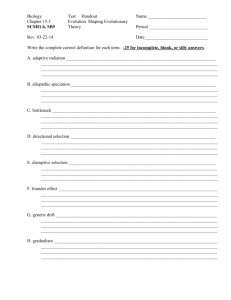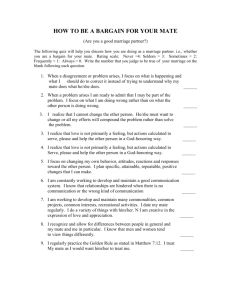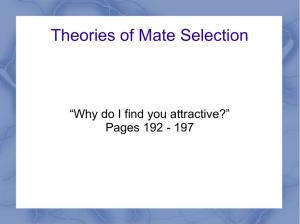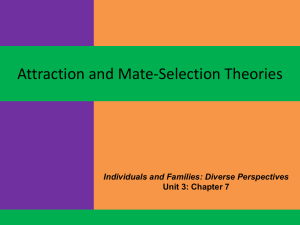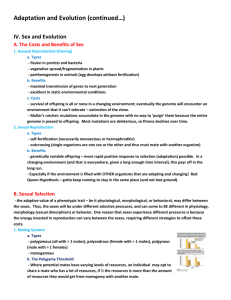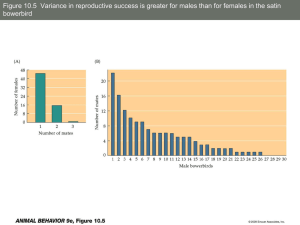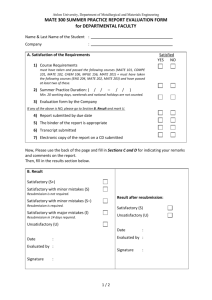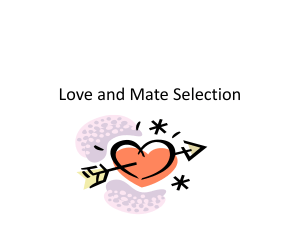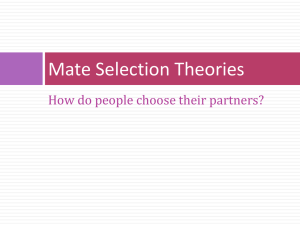Searching for the next best mate
advertisement
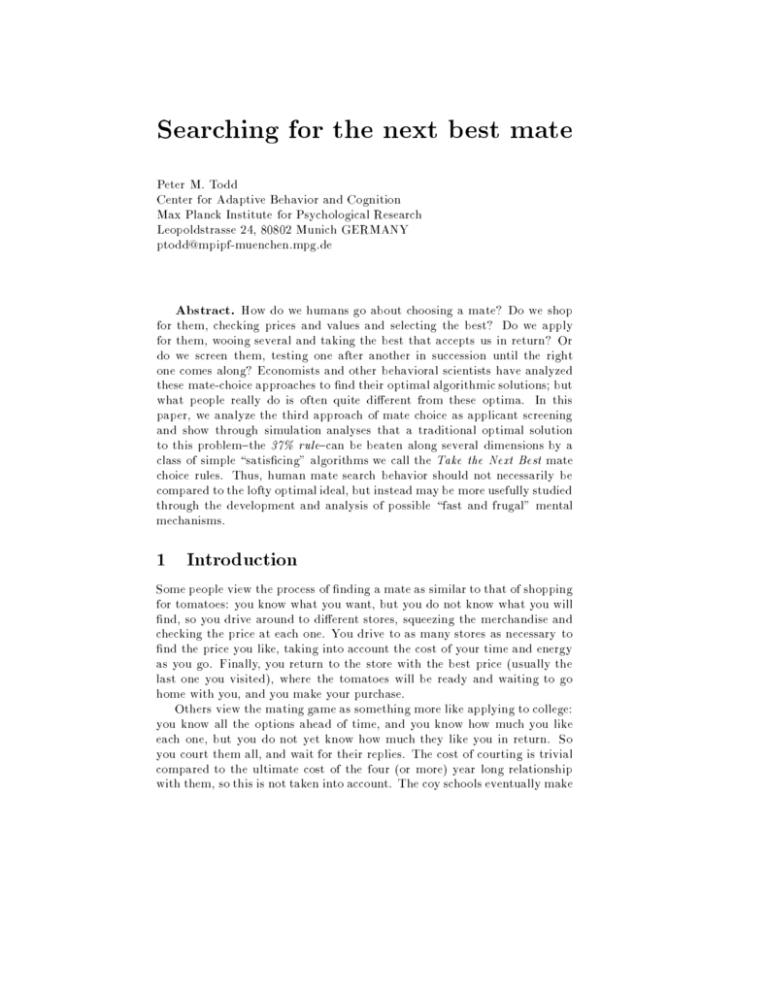
Searching for the next best mate
Peter M. Todd
Center for Adaptive Behavior and Cognition
Max Planck Institute for Psychological Research
Leopoldstrasse 24, 80802 Munich GERMANY
ptodd@mpipf-muenchen.mpg.de
Abstract. How do we humans go about choosing a mate? Do we shop
for them, checking prices and values and selecting the best? Do we apply
for them, wooing several and taking the best that accepts us in return? Or
do we screen them, testing one after another in succession until the right
one comes along? Economists and other behavioral scientists have analyzed
these mate-choice approaches to nd their optimal algorithmic solutions; but
what people really do is often quite dierent from these optima. In this
paper, we analyze the third approach of mate choice as applicant screening
and show through simulation analyses that a traditional optimal solution
to this problem{the 37% rule{can be beaten along several dimensions by a
class of simple \satiscing" algorithms we call the Take the Next Best mate
choice rules. Thus, human mate search behavior should not necessarily be
compared to the lofty optimal ideal, but instead may be more usefully studied
through the development and analysis of possible \fast and frugal" mental
mechanisms.
1 Introduction
Some people view the process of nding a mate as similar to that of shopping
for tomatoes: you know what you want, but you do not know what you will
nd, so you drive around to dierent stores, squeezing the merchandise and
checking the price at each one. You drive to as many stores as necessary to
nd the price you like, taking into account the cost of your time and energy
as you go. Finally, you return to the store with the best price (usually the
last one you visited), where the tomatoes will be ready and waiting to go
home with you, and you make your purchase.
Others view the mating game as something more like applying to college:
you know all the options ahead of time, and you know how much you like
each one, but you do not yet know how much they like you in return. So
you court them all, and wait for their replies. The cost of courting is trivial
compared to the ultimate cost of the four (or more) year long relationship
with them, so this is not taken into account. The coy schools eventually make
their choices as well, and you end up with the rst one on your preference
list that also favored you.
The real situation in human mate choice is, of course, somewhere inbetween these two idealized cases. As in tomato shopping, the full list of
candidates is never known ahead of time; but as in college admissions, the
candidates are rating and deciding on you in return. Unlike tomato shopping,
the costs associated with search are not simply time and energy, and the
candidates are not waiting for you to make up your mind; unlike college
shopping, there are real costs associated with considering extra candidates,
and the rank ordering of candidates cannot be determined all at once.
Instead, we can characterize mate choice as a sequential search process,
more akin to hiring a new employee for a job opening: you can interview
a succession of candidates, but in this hypothetical setting you must decide
whether or not to hire each one as you see them{you cannot go back to earlier
candidates that you passed over, because they have gone o and been hired
somewhere else. You cannot know the range of qualications of candidates
ahead of time; instead, you must gure this out as you conduct interviews,
and use that information to decide when to stop and hire the current candidate. You may not even know how many candidates you could possibly look
at, further complicating your search process. In this situation, how are you
to decide when to stop searching and settle down with the current candidate?
(Note that this assumes the current candidate is indeed available to you{but
a nal challenge may lurk: when you at last decide whom you want to hire,
that person may not be impressed enough with your rm to accept your oer.
We return to this challenge in the last section.)
In this paper, we explore some possible answers to the question of how
to go about a sequential mate search. Economists and others have analyzed the mate search and matching problem from a variety of viewpoints,
including those represented in these three stories, and have proposed optimal
algorithms for each. But what people do is often quite dierent from what
optimality would predict. We often behave in a bounded rational fashion,
using simple algorithms and heuristics to achieve a \satiscing" solution to a
problem in a faster, less information-intensive way. It is important to understand these algorithms and their information processing abilities, because this
can also shed light on the nature of the adaptive problem these algorithms
evolved to solve, and the kinds of information environments they evolved in.
For example, as we will discuss later, it is commonly believed that humans
do not search long enough when looking for a mate (Frey & Eichenberger,
1996); but the class of simple sequential search algorithms we explore here
challenges this view, showing how robust search performance can be achieved
without looking too long, and indicating that our evolved search behaviors
could in fact be well-adapted to the mate environment in which they operate.
The problem of sequential search has been explored extensively over the
last three decades in exquisite mathematical detail (see for example Fergu-
son, 1989, and Corbin, 1980). So why is there anything left to say about
this problem, and why should we say it with simulations rather than explicit derivations? The answer to both questions is the same: because we
want to explore a range of psychologically plausible alternative algorithms
for performing adaptively in sequential search. The mathematical analyses
of this problem have focused almost exclusively on nding the optimal solution under a variety of conditions. These solutions have often been quite
complex, with little regard for their feasibility when implemented by real
non-mathematician organisms. (Corbin, 1980, however, does take cognitive
limitations into account.) Instead of this top-down analytical approach, we
start here from the bottom and work our way up, asking how far very simple search rules can get us in this domain{something that the mathematical
analyses have largely not addressed. To undertake this exploration, a convenient approach is to use individual-based simulation models, in which we
instantiate mate search algorithms in articial individuals who live and mate
in representative environments. This way, we can test the algorithms' performance directly. For simple situations, this simulation approach is merely an
augmentation and conrmation of (or substitute for) mathematical analysis;
but when the conditions become more complex, as for instance when we add
in mutual mate search between the two sexes (in later papers), mathematical
tractability begins to plummet, and the usefulness of simulation models for
exploration becomes a necessity.
In the next section, we briey discuss the past optimal and behavioral,
satiscing approaches to mate search when conducted as tomato shopping
and college applying, and then concentrate on the mate-choice-as-applicanthiring (or, as we reframe it, dowry-maximizing) view of human mate search
and its optimal solution, the so-called 37% rule. Then in section three we
discuss a class of simple satiscing approaches to this problem, which we
call the Take the Next Best mate choice rules. We show how well these
rules do in comparison to the optimal method through simple simulations
with small populations, and how their behavior changes as the population
of potential mates grows larger. We also indicate the implications of these
results in terms of the \fast and frugal" (Gigerenzer & Goldstein, 1996)
satiscing view of human behavior. Finally, we conclude with a discussion of
the further directions that we can take to explore the mate search and choice
algorithms that we humans really use.
2 Dierent types of mate search: optimal and
actual behavior
Darwin (1871) began the serious evolutionary-minded study of how animals
including humans choose their mates, and of the eects over time of these
search and choice behaviors. In the past few years, research in this area has
exploded, both in terms of how humans (e.g. Buss, 1994) and other animals
(e.g. Bateson, 1983) choose mates, and the evolutionary eects of sexual
selection through mate choice (e.g. Ridley, 1993, and Miller, in press, for the
eects on human evolution, and Andersson, 1994, and Cronin, 1991, for the
eects on animal evolution; Miller & Todd, 1995, and Todd & Miller, 1993, in
press, present simulation models of the evolutionary eects of mate choice).
Because human mate search and choice are interesting examples of human
choice behavior in general, and because they often have profound economic
impact, economists have become interested in this form of behavior as well
(see e.g. Becker, 1991; Roth & Sotomayor, 1990; Frey & Eichenberger, 1996;
and Harrison & McCabe, 1996).
2.1 Mate search as shopping and applying
Economists have largely been interested in formulating the optimal decision
rules for behavior in mate search and choice situations, and then seeing how
well human behavior matches those optima. Thus, for instance, when the
mate search task can be considered one of shopping for mates with a cost
for search eort, the optimal rule is to keep checking potential mates until the rst one that meets some precalculated reservation value based on
the distribution of mate values and the search cost (Rapoport & Tversky,
1970). However, people do not generally seem to adhere to this optimal behavior. Hey (1982, 1987) has identied several non-optimal satiscing \rules
of thumb" that people often use instead, such as the \one bounce" rule (keep
checking values as long as they go up each time; as soon as they go down, stop
and take the previous value). These non-optimal rules, though, are simpler to
calculate (no need to compute the reservation value), and in practice achieve
performance close to the optimum. (Martin & Moon, 1992, have since gone
further, exploring a wider range of simple search rules both experimentally
and through computer simulations in an approach similar to that we take
here.)
In contrast, when the mate search task is described as one of mutual choice
like applying for colleges, the procedure to follow to ensure that everyone gets
a mate they are happy with is the Gale-Shapley algorithm (Gale & Shapley,
1962). This procedure produces a set of mated pairs from a population of
males and females, and guarantees that no male and female who are not
mated in a pair would both be happier if they were together. In this sense,
the matings produced by the Gale-Shapley rule are stable (and optimal, if
stability is the optimality criterion). This procedure requires that everyone
has a xed preference ranking of all their potential mates, and that they
report this ranking accurately for use in the algorithm. However, as evidenced
by the high divorce rates in many countries (Frey & Eichenberger, 1996),
stable pairings are rather seldom obtained in reality, arguing against the use
of a Gale-Shapley type algorithm by mate-seekers on an individual basis.
And even when a centralized Gale-Shapley procedure is used to make pair
matches, people often misrepresent their true preference rankings to gain
an advantage, and yet end up making the matching procedure work further
against their desires (Harrison & McCabe, 1996).
The optimal matching research begun by Gale and Shapley has spawned
a large literature, as reviewed by Roth and Sotomayor (1990). But the work
in this area assumes that all parties involved have complete knowledge about
their own preferences and the available options to choose among. In contrast,
in the job search literature, preferences and options are usually assumed to
be at least partially unknown, and the search process itself entails ongoing
costs. Roth and Sotomayor (p. 247) indicate that these two kinds of models
can be protably brought together, to explore more realistic mutual search
situations, but point out that this is still an open research area. This mutual
partial-information costly-search model is also exactly what we need in the
case of mate search. Here, we next consider the simplied version of this
problem in which one party searches a stable set of sequential alternatives,
but in section 4 we indicate the direction we are heading in for exploring the
mutual search case.
2.2 A third view: sequential mate search with loss of
candidates
We have just considered the idealized versions of mate choice as tomato
shopping and applying to colleges, and the satiscing approaches people take
to these sorts of problems. But just because we have found evidence for how
people really behave in these kinds of settings does not mean that we know
more about how people really choose mates: if these idealized versions of
mate choice dier from real mate choice in important ways, then people's
behavior in these idealized problems could also dier from their behavior in
real mate choice in signicant ways.
And these idealized versions do indeed dier from the situation that
presents itself to men and women searching for a mate, at least in many
modern Western cultures. This type of mate choice usually consists of a
sequential search through successive potential mates, in which each one is
evaluated and decided on in turn, in a process that can take minutes, hours,
days, or years. (Here the decision can be thought of as whether or not to settle down and have children with a particular person, though other denitions
are possible.) There are certainly costs associated with each person that one
checks out during this search; but perhaps the most signicant cost is that
it is dicult, and often impossible, to return to a potential mate that has
been previously discarded (because they remain in the \mating pool" and are
likely to pair up with someone else in the meantime while one's own search
continues{as countless romantic tragedies of missed opportunities attest). To
further complicate matters, one does not know ahead of time what the range
of potential mates may be: how can we know, during our rst love, whether
someone else might be able to incite still deeper passions, if we just keep
searching long enough to nd them? We cannot even tell how many more
potential mates we may encounter! Given these restrictions on the search
process and lack of knowledge about the space over which we are searching,
nding a mate looks, understandably, like a very daunting problem indeed.
Earlier we compared this sequential mate search problem to a rm trying to hire someone from a stream of job applicants. We can present this
situation in more precise detail, and in a form more closely linked to mate
choice, via the \dowry problem," a well-known puzzle from probability theory
(Mosteller, 1987; Gilbert & Mosteller, 1966; Corbin, 1980; this is also known
as the \secretary problem" or \beauty contest problem" and even \Googol").
A sultan wishes to test the wisdom of his chief advisor, to know if he should
retain this cabinet position. The chief advisor is seeking a wife, so the sultan
takes this opportunity to judge his wisdom: the sultan arranges to have 100
women from the kingdom brought before the advisor in succession, and all
the advisor has to do to retain his post is to choose the woman with the
highest dowry (marriage gift from her family). If he chooses correctly, he
gets to marry that woman, and keep his post; if not, he remains single, and
loses his head. The advisor can see one woman at a time and ask her dowry;
then he must decide immediately if she is the one with the highest dowry out
of all 100 women, or else let her pass by and go on to the next woman. He
cannot return to any woman he has seen before{once he lets them pass, they
are gone forever. Moreover, the advisor has no idea of the range of dowries
before he starts seeing the women. What strategy can he possibly use to
have the highest chance of picking the woman with the highest dowry?
It turns out that the algorithm the advisor should use, to guarantee the
highest chance of choosing correctly, is as follows: He should look at the rst
37 women, letting each one pass, but remembering the highest dowry from
that set{call this value D. Then, starting with the 38th woman, he should
select the rst woman with a dowry greater than D. (For derivations of this
procedure, see Mosteller, 1987; Gilbert & Mosteller, 1966; Ferguson, 1989).
If the advisor follows this procedure, he will have a 37% chance of succeeding
in choosing the woman with the highest dowry. This is the best he can do{no
other algorithm would improve his odds of picking correctly.
More generally, if the advisor knows that he will be presented with a
succession of women from a total set of N women, he should check the rst
37% of those women, remembering the highest dowry, and then select the
rst one after those 37% who exceeds the previous highest value. This 37%
rule, to repeat, nds the highest value more often than any other algorithm
(again, 37% of the time), and thus is, in this sense, the optimal solution to
this problem. The advisor has slightly better than a 1 in 3 shot at picking
the right woman and keeping his head. The other two-thirds of the time,
well, the sultan has to look for another wise man.
2.3 Looking for better search rules
Of course, in the real world, our mating decisions are seldom this dramatic{
we usually get to (or have to) live with whatever choice we make, even if
it was not the \best" one. To the sultan's advisor, the performance of the
37% rule on those occasions when it did not pick the highest dowry did not
matter{he was killed in any case. But to a population of individuals all using
such an algorithm to choose their mates, what this rule does the other 63%
of the time would matter rather a lot. For instance, if applied to a set of
100 dowries ranging from 1 to 100, the 37% rule returns an average value of
about 82 (that is, the mean of all dowries chosen by this rule). Only 67%
of the individuals selected by this rule lie in the top 10% of the population,
while 8% fall in the bottom 25%. And it takes the 37% rule an average of 74
tests of potential mates (that is, double the 37 that must be checked before
selection can begin) before a mate is chosen. (These gures are all discussed
in the next section.) If any of these performance gures could be improved
upon by some other sequential choice algorithm, that algorithm could well
prove more adaptive for a population of mate-choosers, allowing them to
pick better mates more often, or more quickly, or with a smaller chance of
picking a total loser, and we might therefore reasonably expect it to evolve
in preference to the 37% rule.
To the extent that humans use any such sequential search algorithm when
choosing mates, the more adaptive ones (if they exist) would make a better
yardstick against which to compare human behavior. The 37% rule has at
least two disadvantages as a model of human behavior: First, it requires
knowing how many potential mates, N, there are to check through, in order
to calculate how many are in the rst 37% to look at before making a nal
choice. In our ancestral environments, N may not have varied much{our
hunter-gatherer tribe sizes may have been fairly constant, so that an evolved
value of N could be used in this algorithm. But in modern metropolitan
environments, the number of potential mates has increased enormously, and
to work optimally, the 37% rule would have to take those new large values
of N into consideration. Second, this rule requires checking through a large
number of individuals before a decision can be made{74 out of 100 in the
previous example. Even assuming a rather quick assessment of someone's
mate potential, perhaps a few dates over a month's time, the search time
involved becomes extensive.
Thus, using the 37% rule for human mate search may require information
that is dicult to obtain (an accurate value for N), and a large number
of individuals to be checked and consequently a long search time. On the
other hand, Frey and Eichenberger (1996) argue that one of the paradoxes of
marriage is that people search too little for their marriage partners, checking
too few individuals before making a life-long commitment to one of them.
The evidence they cite argues against the presence of the 37% rule in human
mate search{but it also argues that, by not searching long enough, people
are making suboptimal mate choices. If people are not using an algorithm as
long-winded as the 37% rule, what might they be doing instead? And is it
possible that there are any faster search rules that still perform well, so that
Frey and Eichenberger's fears of suboptimal mate choice can be countered?
If so, will these rules prove more complicated? In the next section, we explore
the answers to these questions, and discover that we can in fact do more, in
mate choice, with less.
3 The performance of simpler sequential mate
search algorithms
Optimal rules have been derived for the problem of sequential search in a
variety of settings that are more or less relevant to mate search. For instance, Gianini-Pettitt (1979) analyzed the situation in which the number
of potential mates to be searched through is unknown. Corbin (1980) came
up with methods for specifying search processes when the searcher can be
satised with outcomes that are not necessarily ranked as number one (that
is, where getting the second best, or third best, etc., all have some non-zero
utility as well). She also considered the case where past candidates might
still be available for the searcher to return to, with some probability{in this
situation, it is sometimes best to search through the whole set of potential
candidates and try to go back to the best one once the end of the sequence has
been reached. Gilbert and Mosteller (1966) looked at situations where the
distribution of candidate values is known or unknown, and at what happens
when the searcher can select several candidates (i.e., be a polygamist, and try
to get the best mate among the set of candidates chosen). And Quine and
Law (1996) found optimal algorithms for maximizing the rank of a selected
candidate (as opposed to maximizing the probability of selecting the absolute
top candidate).
However, these optimal solutions generally require longer search, or more
knowledge, or greater computation, than even the basic 37% rule. For instance, Quine and Law's (1996) algorithm for maximizing the selected rank
has the searcher rst check some number of individuals, and then take the
next best one after up to some next point in the sequence, and then select any
candidate in the top two relative-rank positions up to another later point in
the sequence, and then select any candidate in the top three positions, and so
on, successively lowering one's standards as the search progresses. While this
makes intuitive sense (and works quite well), it involves a lengthy search (on
average) and the non-trivial computation of multiple criterion-shifting points,
all of which makes this algorithm ultimately less psychologically plausible. Instead, we wanted to start with very simple search rules which most people
would agree could be psychologically plausible (or at least could be easily
followed by an organism), and see how well{or how far below optimum{these
simple rules could also do in the search task. If they do well, we will have
a simpler baseline against which we can compare human behavior (and a
candidate set of rules to look for evidence of in human behavior), and if not,
then we can begin to enhance them, adding slowly to their complexity until
they do perform adaptively.
To investigate whether or not any simple sequential search rules exist that
can outperform the standard 37% rule in the standard \secretary problem"
search domain in various ways, we began by studying a class of rules derived
from the 37% rule. It turned out that even this small set of rules contained
some which are better than the 37% rule on many dimensions, and so we
restrict our discussion here to this type of rule (with the understanding that
other types of search algorithms or rules, which we are currently exploring,
may prove to have even better performance). We have dubbed the class
of rules we consider here the Take the Next Best (TNB) mate-choice rule
family (after the Take The Best or TTB decision algorithm of Gigerenzer
and Goldstein, 1996, which is a prime example of a simple satiscing mental
mechanism).
TNB rules work in direct analogy to the 37% rule as follows: for some
specied C, the rst C% of the N total potential mates are checked (without
being selected), and the highest dowry D is remembered. After the rst
C% of potential mates have gone by, the next potential mate with a dowry
greater than D is the one chosen. (If no greater dowry turns up, then we
assume that the searcher accepts the very last individual in the sequence{
this is why our performance curves in the gures to come do not end up going
to zero.) This simple sort of algorithm (of which the 37% rule is one specic
example) has minimal cognitive requirements: it only uses memory for one
value at a time (the current highest dowry), only needs to know N and C and
calculate NxC/100, and only needs to be able to compare two dowry values
at a time. What we want to know is how the performance of these simple
algorithms changes as we change the percent of potential mates checked, C.
Because we also wanted to be able to change the underlying assumptions of
this problem, such as the distribution of dowry values, or the cost of checking
each potential mate, or whether or not N is even known, the mathematics
quickly grew complicated, and we decided on a much more exible simulation
approach to these questions.
We tested the behavior of TNB search algorithms with values of C from
0% (corresponding to always choosing the rst potential mate) to 15% in
increments of 1%, from 20% to 50% in increments of 5% (except around 37%
where we again increased the resolution), and from 60% to 90% in increments
of 10% (because we believed more of the action{good performance{would
occur in the lower C ranges). We ran each rule in a variety of \mate environments," or dierent numbers N and distributions of dowry values. For each
such mate environment, we ran each rule against 10,000 dierent randomlycreated dowry (or mate value) lists. We collected statistics on the distribution
of mate values selected by each algorithm (including the mean, standard deviation, quartile distributions, and number of times the single best dowry
value was chosen) and positions at which mates were selected (the mean and
standard deviation). With these values in hand, we can answer the questions
posed at the end of the previous section: can another sequential mate search
algorithm beat the 37% rule?
3.1 Performance of TNB rules with 100 potential mates
The answer, even from the class of simple-minded TNB rules, is a resounding
\yes." It is true, the 37% rule yields the highest mate value most often
when the distribution of mate values is created without replacement (i.e.
no duplicate values). But when we start relaxing the mate choice criterion
slightly, as we do in Figure 1, this rule begins not to look so good. In the
gure, the \Top 1" line shows the number of times out of 10,000 that the
highest mate value was picked by a TNB algorithm, for dierent numbers of
\dates" (potential mates) checked (i.e. dierent values of C{here C is out of
100, so it is equivalent to percentage as well). (See Gilbert & Mosteller, 1966,
Figure 1, p. 42, for the mathematically-derived equivalent of this function.)
This curve exhibits a classic at maximum, so that it does not much matter
what exact value of C is used{the results are largely the same for C between
20% and 40%. The greatest chance of choosing the highest mate value or
dowry comes with a C of 37%, as expected, but this highest-value mate is
only found in 37% of the cases. And things get worse from here.
An animal searching for a mate is probably not, as we mentioned earlier,
only willing to settle for the \best" member of the opposite sex{other \pretty
good" potential mates will often be selected instead, to save search time or
energy (or even because the animal cannot perceptually distinguish between
\best" and \pretty good"). It may suce, in terms of having an adaptive
advantage over other competing mate-seekers, to nd a potential mate with
a mate value in the top 10% of the population relatively quickly. In Figure
1, we see that the value of C that returns the most chosen mates in the
top 10% of the value distribution is only 12%, and checking the rst 12% of
the sequence of mates before making a nal choice results nding a top-10%
mate over 77% of the time. If one's standards are a bit more lax, and it
is only desired to obtain a mate in the highest quartile (top 25%) with the
greatest chance, then only C=8% of the initial stream of potential mates
need be checked, yielding mates in that top quartile over 90% of the time.
Finally, rather than being risk-seeking in searching for a mate in the top
ranks of the population, an animal may be risk-averse, preferring only to
minimize its chances of landing a mate with a value in the bottom quartile
of the population, where the mutants lie. From the line marked \Bottom
25%" we can see that the way to achieve this goal is to use a much lower
C of 2%, yielding only 1% of chosen mates being from the bottom (quarter)
of the barrel. The 37% rule would pick these poor mates over 11% of the
100.00
Top 25%
Top 10%
Top 1
Bottom 25%
Percent of mates in each category
80.00
60.00
40.00
20.00
0
0
20
40
60
Number of possibilities checked
80
100
Figure 1: Chance of nding a mate in a particular category, given dierent
number of mates checked rst before taking the next best, out of 100 total
possible mates.
time{much worse performance by risk-averse standards.
If instead an animal would gain the most adaptive advantage over its competitors by simply maximizing its average selected mate value over multiple
uses of its TNB sequential search algorithm, Figure 2 shows how to accomplish this goal. By using C=8% in this environment of 100 potential mates,
over time the searcher will select mates with an average mate value of 89. In
contrast, if the searcher were to use the 37% rule, they would only average
74 (which is, in fact, the same performance level as if they checked only 1%
of the population before taking the next best candidate!).
The mate value selected by these search algorithms may not be the only
criterion that matters to a mating animal{the time and energy spent searching may also strongly inuence the adaptiveness of the algorithm used (see,
e.g., Pomiankowski, 1987; Sullivan, 1994). In Figure 3, we see how many
total potential mates must be looked at, on average, before the nal mate is
chosen, varying as a function of the number of potential mates checked, C,
before mate selection can begin. For the 37% rule operating in this environment, 74 potential mates must be looked at on average before a nal mate is
selected. With lower values of C, the number of mates that must be looked
at falls o rapidly, with increasing advantage as C decreases. The optimal
value of C according to this criterion is C=0, i.e., pick the rst potential mate
100
Average mate value
80
60
40
20
0
0
20
40
60
Number of possibilities checked
80
100
Figure 2: Average value of selected mate (bars indicate one standard deviation), given dierent number of mates checked rst before taking the next
best, out of 100 total possible mates.
encountered. When combined with the other criteria, the exact cost assigned
for each potential mate looked at will determine the precise tradeo between
nding a good mate and spending time and energy looking for that mate.
3.2 Performance of TNB rules with a greater number
of potential mates
All of these criteria, beyond maximizing the chance of picking the single best
mate, point to TNB rules with C other than 37%. Checking about 10% of
the population of potential mates before selecting the next highest one to
follow will result in just about the highest average mate value possible, most
of the chosen mates in the top quartile and three quarters of them in the top
10%, and a search through 36 or so potential mates before the nal selection
is made. This seems like quite reasonable performance, especially because it
means only checking 10 individuals initially out of the whole list of 100. But
what happens if the population size is increased to 1000? Then checking 10%
means testing 100 individuals, which starts to seem less like fun and more
like hard work. If the number of individuals that must be tested by a TNB
rule goes up linearly with the total population size (which it will do of course
if C is a percentage, rather than a cardinal number), these rules may not end
100
Average mate position
80
60
40
20
0
0
20
40
60
Number of possibilities checked
80
100
Figure 3: Average position at which a mate is selected (bars show one standard deviation), given dierent number of mates checked rst before taking
the next best, out of 100 total possible mates.
up being so \fast and frugal," at least for larger populations, after all.
But Figure 4, testing TNB rules in a population of 1000 potential mates
with mate values from 0 to 1000 (with possible duplicates), shows that our
fears of linear time increase are unwarranted. As before, the greatest chance
of picking the single highest-value mate (or biggest dowry) comes from rst
checking 25-30% of the population. But to maximize the chances of picking a
mate in the top 10% (with a 95% probability), only 3% of the potential mates
need to be checked rst to nd D; and for a mate in the top 25% (with a
98% probability), only 1% of the potential mates need be checked. Similarly,
to minimize the chances (to 0.4%) of choosing a rotten mate in the bottom
25%, only 1% of population needs to be checked. And nally, to maximize
the actual mean value of the selected mate, only 3% of the population should
be checked, as shown in Figure 5.
Thus, to maximize potential mate value and minimize risk in this population of 1000 potential mates, somewhere between 1% and 3% of the population, or 10 and 30 individuals, should be rst checked to come up with
the target value for D. In the previous population of 100 individuals, also
checking about 10 of them resulted in top search performance along these
criteria. So despite the tenfold increase in population size, the number of
individuals to check has increased only slightly. This suggests that our TNB
100.00
Top 25%
Top 10%
Top 1
Bottom 25%
Percent of mates in each category
80.00
60.00
40.00
20.00
0
0
200
400
600
Number of possibilities checked
800
1000
Figure 4: Chance of nding a mate in a particular category, given dierent
number of mates checked rst before taking the next best, out of 1000 total
possible mates. Note that a smaller percentage of potential mates need now
be checked to maximize the chances of getting a top mate.
rules can be simplied, so that instead of requiring that C% of the population
is checked to come up with a value for D, now only C{a number independent
of population size over a wide range, for instance C=12 (\Take a dozen")
for population sizes from 100 to 1000 or so{need be checked. Furthermore,
this answers the criticisms of the 37% rule raised at the end of the last section: a simple sequential search rule that performs better than the 37% rule
in several aspects does indeed exist, and it does not need knowledge of the
total population size, nor require that an inordinate number of individuals
be checked before a choice can be made. Finally, these results indicate that
Frey and Eichenberger's (1996) pessimism over short-searching humans ever
nding their ideal mate may be unfounded: even a little bit of search may
go a long way.
4 Further directions
Of course, we have left much out of this discussion of mate search. In focusing
on the processes by which one individual can nd his or her semi-ideal mate,
we have neglected all aspects of mutual choice. Being able to have a high
1000
Average mate value
800
600
400
200
0
0
200
400
600
Number of possibilities checked
800
1000
Figure 5: Average value of selected mate (bars indicate one standard deviation), given dierent number of mates checked rst before taking the next
best, out of 1000 total possible mates. Note that a smaller percentage of
potential mates need now be checked to maximize the average selected mate
value.
probability of nding a good-quality mate quickly is certainly important; but
in our species at least, that is usually only half the battle. We must also worry
about being chosen by the other individual in return (as emphasized in the
mate-choice-as-college-application scenario). This is the two-sided matching
situation of Gale & Shapley, 1962, and Roth & Sotomayor, 1990, which must
be combined with the limited-knowledge costly-search situation we have addressed here. We can (and will) examine the mutual choice behavior of TNB
rules by incorporating them into a whole population of mate-searching individuals and recording the number of iterations it takes for everyone in the
population to either get matched up or fail to nd a mate. We will compare
this behavior to that of an optimal matching rule like the Gale-Shapley algorithm in terms of population stability, number of unmated individuals, and
time to settle. It may be that a simple, fast and frugal algorithm like TNB
can outperform others along important dimensions such as these.
But this is another issue we must address: what are the most important
dimensions over which search algorithms like these should be compared? Here
we have argued that nding the absolute best individual in a population is
not necessarily the most adaptive goal, if the search time, or mean mate
value, or distribution of mate values, can be improved upon. But we need
to support this claim. One way to approach this problem is to create evolutionary simulations in which dierent algorithms compete with each other
for mates and ospring, and see which types of algorithms win out over time.
This approach, though, will only succeed in telling us something about real
evolved human (or animal) behavior to the extent that we successfully incorporate the relevant ecological details (of how mate value maps onto number
of ospring, for instance) into our model.
Another approach to this question is to study the actual evolved search
behavior that humans and other animals use, as others have done in dierent
settings (e.g. Hey, 1982, 1987; Harrison & McCabe, 1996; Martin & Moon,
1992; Rapoport & Tversky, 1970; Sethuraman, Cole, & Jain, 1994; Alatalo,
Carlson, & Lundberg, 1988). We are interested in pursuing this line of evidence as well, but there is always the concern that experimental situations
may not tap into the mental mechanisms used in real-world behavior. Alternatively, we can look for evidence of dierent search algorithms in the real
observed mate search behavior of people and other animals; we are currently
exploring the options of existing mate search databases.
But our main goal will continue to be to seek simple but eective possible mental algorithms for the mate search task, and test these algorithms
through simulation in a variety of mate population environments. In this
way, we hope to discover further \fast and frugal" algorithms, like the class
of TNB rules we have presented here, that produce adaptive behavior with a
minimum of information and computation. Finding a good-enough mate, as
making a variety of choices, does not require optimal and expensive cognitive
algorithms. Whether hoping for a ripe tomato, a willing college, or a vast
dowry, it may not take much to get the next best thing.
Acknowledgments
Thanks to Ron Todd, Georey Miller, David K. Smith, and the members
of the Center for Adaptive Behavior and Cognition (ABC) in Munich for
helpful comments on this work.
References
Alatalo, R. V., Carlson, A., & Lundberg, A. (1988). The search cost in mate
choice of the pied ycatcher. Animal Behaviour, 36(1), 289-291.
Andersson, M. (1994). Sexual selection. Princeton, NJ: Princeton University
Press.
Bateson, P.P.G. (Ed.) (1983). Mate choice. Cambridge, UK: Cambridge University Press.
Becker, G. (1991). A treatise on the family. Cambridge, MA: Harvard University
Press.
Buss, D. M. (1994). The evolution of desire: Strategies of human mating. New
York: Basic Books.
Corbin, R. M. (1980). The secretary problem as a model of choice. Journal of
Mathematical Psychology, 21(1), 1-29.
Cronin, H. (1991). The ant and the peacock: Altruism and sexual selection from
Darwin to today. Cambridge, UK: Cambridge University Press.
Darwin, C. (1871). The descent of man, and selection in relation to sex (2 vols.).
London: John Murray.
Ferguson, T.S. (1989). Who solved the secretary problem? Statistical Science,
4, 282-296.
Frey, B. S., & Eichenberger, R. (1996). Marriage paradoxes. Rationality and
Society, 8(2), 187-206.
Gale, D., & Shapley, L. (1962). College admissions and the stability of marriage.
American Mathematical Monthly, 69, 9-15.
Gianini-Pettitt, J. (1979). Optimal selection based on relative ranks with a
random number of individuals. Advances in Applied Probability, 11, 720-736.
Gigerenzer, G., & Goldstein, D. (1996). Reasoning the fast and frugal way:
Models of bounded rationality. Psychological Review, 103(4), 650-669.
Gilbert, J.P, and Mosteller, F. (1966). Recognizing the maximum of a sequence.
American Statistical Association Journal, 61, 35-73.
Harrison, G.W., & McCabe, K.A. (1996). Stability and preference distortion
in resource matching: An experimental study of the marriage problem. In
R.M. Isaac (Ed.), Research in experimental economics, vol. 8. Greenwich:
JAI Press.
Hey, J. D. (1982). Search for rules for search. Journal of Economic Behavior
and Organization, 3, 65-81.
Hey, J. D. (1987). Still searching. Journal of Economic Behavior and Organization, 8, 137-144.
Martin, A., & Moon, P. (1992). Purchasing decisions, partial knowledge, and
economic search: Experimental and simulation evidence. Journal of Behavioral Decision Making, 5(4), 253-266.
Miller, G. F. (in press). Sexual selection in human evolution: Review and
prospects. To appear in C. Crawford & D. Krebs (Eds.), Evolution and
human behavior: Ideas, issues, and applications. Mahwah, NJ: Lawrence
Erlbaum.
Miller, G. F., & Todd, P. M. (1995). The role of mate choice in biocomputation:
Sexual selection as a process of search, optimization, and diversication. In
W. Banzhaf & F. H. Eeckman (Eds.), Evolution and biocomputation: Computational models of evolution. (Lecture notes in computer science 899, pp.
169-204.) Berlin: Springer-Verlag.
Mosteller, F. (1987). Fifty challenging problems in probability with solutions.
New York: Dover. (Reprint of the 1965 Addison-Wesley edition.)
Pomiankowski, A. (1987). The costs of choice in sexual selection. Journal of
Theoretical Biology, 128, 195-218.
Quine, M.P., and Law, J.S. (1996). Exact results for a secretary problem. Journal of Applied Probability, 33, 630-639.
Rapoport, A., & Tversky, A. (1970). Choice behaviour in an optimal stopping
task. Organizational Behaviour and Human Performance, 5, 105-120.
Ridley, M. (1993). The red queen: Sex and the evolution of human nature.
London: Viking.
Roth, A. E., & Sotomayor, M. (1990). Two-sided matching: A study in gametheoretic modeling and analysis. Cambridge, UK: Cambridge University
Press.
Sethuraman, R., Cole, C., & Jain, D. (1994). Analyzing the eect of information
format and task on cuto search strategies. Journal of Consumer Psychology
3(2), 103-136.
Sullivan, M. S. (1994). Mate choice as an information gathering process under time constraint: Implications for behaviour and signal design. Animal
Behaviour, 47(1), 141-151.
Todd, P. M., & Miller, G. F. (1993). Parental guidance suggested: How parental
imprinting evolves through sexual selection as an adaptive learning mechanism. Adaptive Behavior, 2(1), 5-47.
Todd, P. M., & Miller, G. F. (in press). Biodiversity through sexual selection.
To appear in C. Langton (Ed.), Articial Life V. Cambridge, MA: MIT
Press/Bradford Books.
